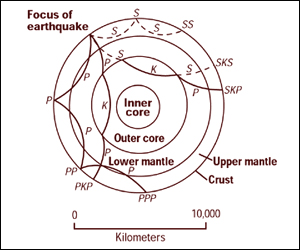NASA InSight to probe the heart of Mars using 'marsquakes'
Meteorologist/Science Writer
Saturday, May 5, 2018, 7:45 AM - NASA launched their newest Mars lander, InSight, Saturday morning, on a historic mission that will give us our first detailed look at the heart of the Red Planet, using a phenomenon known as 'marsquakes'.
On May 5, 2018, at 7:05 a.m. EDT, the new Mars InSight mission lifted off from Vandenberg Air Force Base, in California to, as NASA puts it, "investigate processes that shaped the rocky planets of the inner solar system more than four billion years ago."
Watch, below, for replay of this very first interplanetary launch from the U.S. west coast!
What is InSight?
InSight, which stands for Interior Exploration using Seismic Investigations, Geodesy and Heat Transport, will accomplish its mission by using an array of sensors, but the most important is its Seismic Experiment for Interior Structure (SEIS), which will be placed on the Martian surface, beside the lander, to detect tremors in the ground.

This artist rendition depicts NASA's Insight lander on the surface of Mars. The lander's various scientific instruments are labelled, with SEIS visible on the ground, next to the lander. Click or tap the image to find out more about Insights array of instruments. Credit: NASA/JPL-Caltech
Here on Earth, seismologists have used the waves of motion that are set off in the ground by earthquakes to tell what the interior of the planet looks like, with its various layers - the crust, the upper and lower mantle, and the outer and inner core. This is based on the fact that these seismic waves travel at different speeds depending on what type of stuff they're travelling through. So, by sensing an earthquake from different locations around the world, they can use the time it took the vibrations from the quake to reach specific sensors to determine what kinds of materials those vibrations passed through.
|
|
Using the same methods that seismologists use here on Earth, InSight scientists will be able to use these tremors, which they've named "marsquakes", to get an idea of what the interior of Mars looks like.
If we already have an excellent idea of what the interior of Earth looks like, what use is there in probing the interior of another rocky world?
According to NASA:
Because Mars has been less geologically active than the Earth (for example, it does not have plate tectonics), it actually retains a more complete record of its history in its own basic planetary building blocks: its core, mantle and crust.
By studying the size, thickness, density and overall structure of the Red Planet's core, mantle and crust, as well as the rate at which heat escapes from the planet's interior, the InSight mission will provide glimpses into the evolutionary processes of all of the rocky planets in the inner solar system.
No plate Tectonics? Where to marsquakes come from?
It's true. Mars is not tectonically active, so it does not have pieces of its crust moving about, to grind together, to produce marsquakes. This is due to the planet being much smaller than Earth, thus its interior cooled much more quickly, and it is generally thought that the inside of the planet is fairly dormant, compared to Earth.
So, how do marsquakes happen? The best guesses at the moment are that they may be due to the planet shrinking, ever so slightly, as the interior continues to cool (Yup! Mars may be getting smaller!), or by pockets of magma rising to the surface (if there still are large pockets of magma), or by meteorite strikes.
When a meteoroid plunges into Earth's atmosphere, it produces a bright flash as it compresses the air in its path, and the immense pressures that are exerted on the meteoroid by that compressed air typically cause the rock to break apart, sometimes explosively.
"However, on Mars we think that meteoroids may not necessarily burn up entirely upon encountering the martian atmosphere," Katarina Miljkovic, a planetary scientist at Curtin University, in Perth, Australia, who is collaborating on the InSight mission, wrote in The Conversation. "This is simply because Mars has a less dense atmosphere than the Earth - so incoming meteoroids have a higher penetrating power. These impact events would produce seismic disturbance in the atmosphere, and also likely in the ground."
With Mars so much closer to the asteroid belt, it is probably pummeled by meteorite strikes, on a fairly regular basis. InSight will be able to detect those strikes.
According to NASA, we have seismic data from the old Viking 1 and 2 landers, which landed on Mars in 1976. However, Viking 1's instrument failed, and even after 500 Martian days of operation, Viking 2's seismic instrument only detected one potentially-seismic event. Since the Viking 2 instrument did not actually touch the ground, directly, it detected far more noise from the winds.
With InSight's SEIS instrument being placed directly on the Martian ground, it should be able to detect even the most sensitive vibrations, while being shielded from the wind by its hemispherical casing.

An artist’s rendition of the InSight lander operating on the surface of Mars. Credits: NASA/JPL-Caltech
InSight is scheduled to arrive at Mars in late November.
Sources: NASA | The Conversation | NASA




